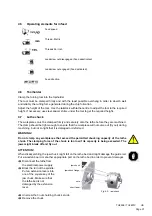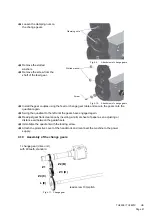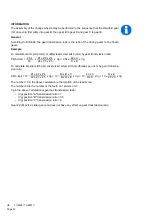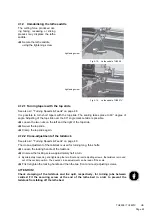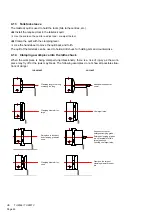
Page 50
TU2506
ǀ
TU2807V
US
4.18
Calculating RPM
The RPM setting depends on the cutting speed and the diameter of the part. The RPM setting
will change with the diameter of the part. As the diameter of the part gets smaller, the RPM
must increase to maintain the recommended surface feed. Conversely, as the diameter of the
part gets larger, the RPM must decrease. Therefore, to maintain the recommended cutting
speed, larger diameter parts must be run at slower speeds than a smaller diameter part.
To calculate the proper RPM for the tool and the workpiece, the following formula should be
used:
This simplified version of the RPM formula can be used for other machining operations as well.
Let's use this formula to work in calculating the RPM for the machining example below. Use the
recommended cutting speed charts
"Recommended Cutting Speeds in Feet per Minute for
Turning Ferrous and Nonferrous Metals*“ on page 48.
A cut is to be made with a high-speed steel (HSS) tool on a 2-inch diameter piece of 1018 steel
with a Brinnel Hardness of 150 HB. Calculate the RPM setting to perform this cut.
Cutting Speed (CS) = 120 fpm
Diameter of part (D) = 2”
Since the available spindle speed settings are generally not infinitely variable, the machine can-
not be set precisely to the calculated RPM setting. Some judgment must be made in selecting
the speed to use. Try to get to the speed which is nearest to the calculated RPM, but if you
can't, consider these conditions. Are you roughing or finishing? If you are roughing, go slower. If
you are finishing, go faster. What is your depth of cut? If it is a deep cut, go to the slower RPM
setting. Is the setup very rigid? Go slower for setups that lack a great deal of rigidity. Are you
using coolant? You may be able to go to the faster of the two settings if you are using coolant.
The greatest indicator of cutting speed is the color of the chip. When using a high-speed steel
cutter the chips should never be turning brown or blue. Straw-colored chips indicate that you
are on the maximum edge of the cutting speed for your cutting conditions. When using carbide,
chip colors can range from amber to blue, but never black. A dark purple color will indicate that
you are on the maximum edge of your cutting conditions.
Let's try some other examples:
A cut is to be taken with a (HSS) turning tool on a 1/2 inch piece of 1045 steel with a Brinnel
Hardness of 250 HB. Calculate the RPM setting to perform this cut.
Cutting Speed (CS) = 70 fpm
Diameter of part (D) = 0.5"
A 3/8-inch (HSS) drill is used on a 4-inch diameter piece of 1012 steel with a hardness of 100
HB. Calculate the RPM setting to perform this drilling operation.
Cutting Speed (CS) = 140 fpm
Diameter of the drill (D) = 0.375"
Cutting Speed (Cs) x 4
Part Diameter (D)
RPM =
Cs x 4
D
=
120 x 4
2
=
480
2
= 240 RPM
RPM =
Cs x 4
D
=
70 x 4
0.5
=
280
0.5
= 560 RPM
RPM =
Cs x 4
D
=
140 x 4
0.375
=
560
0.375
= 1493 RPM
Содержание TU 2506
Страница 1: ...US Item No 9684509 Operating manual Version 2 2 2 Lathe...
Страница 28: ...Page 28 TU2506 TU2807V US 3 7 2 Chuck flange TU2506 TU2807V Fig 3 1 Chuck flange TU2506 TU2807V Unit mm...
Страница 74: ...Page 74 TU2506 US...
Страница 92: ...Page 92 TU2506 TU2807V US 8 Wiring diagrams 8 1 TU2506 Fig 8 1 Wiring diagram TU2506...
Страница 93: ...Page 93 TU2506 TU2807V US 8 2 TU2807V 230V Fig 8 2 Wiring diagram TU2807V...
Страница 98: ...Page 98 TU2506 TU2807V US...


